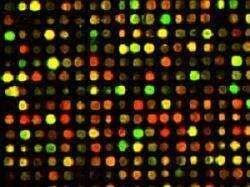

DNA Microarray technology is one of the most exciting new technologies in science and medicine. Often known as gene profiling it offers great promise to more accurately diagnose lymphoma and tailor treatments to each patient.

Our goal on this page is not to teach you all the ins and outs of exactly what it is and how it works in all its glorious technical details. Here you will simply find a generalized description of what it is, and why it might be important in the diagnosis and treatment of lymphoma. Then at the bottom you will find several excellent links where you can find much more detailed and technical information.
Let's start by talking about what it is. Microarray testing is quite simply a way of testing a sample of cells and find out what genes are expressed and what genes are not expressed in that sample. This eventually will allow researchers to learn in much greater details the exact make up of the various cells they are interested in (in our case lymphoma cells). If they include a sample of normal healthy cells in the test, then they can easily compare the diseased cells to the healthy ones and find out what is different in the form of gene expressions. Not only will this help them to understand what makes lymphoma (and many other diseases) tick, but it will also eventually lead them to find treatments that can be tailored to each patient because they will know what treatments work with each combination of gene expression.
The quick and not so technically accurate explanation of how it works is this. First you start with a chip which often resembles a glass microscope slide. On that chip you attach copies of the DNA of genes you wish to test for. Remember, genes and DNA are microscopic in size so this chip can contain one, or THOUSANDS of gene samples and still be very small. What is important is that the genes placed on that chip are in a specific and known location. Sort of like a chessboard where you know the starting location of every piece. See the image at the top left for an actual (very enlarged) example.
Next you take the sample cells you want to test. Skipping a whole lot of technical stuff you attach a coloured fluorescent tag to those samples. In many cases you will also include healthy normal cells with a different coloured fluorescent tag.
Skipping a whole lot more technical stuff you now mix the sample cells with the microarray chip. The DNA samples will attach (hybridize) to the sites on the chip that have the same genes they do. When you aim a laser at the chip the sample cells will light up and by examining the sites where they light up you know what genes they attached to, and thus you know what genes the sample cells are expressing. If you include healthy cells in the sample you can also see if both colours show up or if only the healthy cell colour shows up, in which case you know that the sample (diseased) cells are under expressing certain genes that healthy cells normally express. As you may see at this point, you can now compare what genes are expressed on healthy cells, what genes are expressed on diseased cells, and which genes are not expressed on one or the other.
DNA microarray is new and exciting but it is not a routine part of lymphoma diagnosis or follow up. In most cases it will be used only in clinical studies because scientists still don't know all the implications of the various gene combinations and how they affect the behaviour and treatment of lymphoma. But you can be sure it won't take them long to figure it all out as this technology becomes more widely used.
How has Microarray testing helped understand follicular lymphoma? Here is an article on that very subject
Gene profiling in follicular lymphoma
How has Microarray testing helped understand diffuse large B-cell lymphoma? Here is an article on that subject
Gene profiling in diffuse large B-cell lymphoma
From the US National Institutes of Health comes The Human Genome Project Research Institute page all about DNA microarray. This is another excellent easy to understand site.